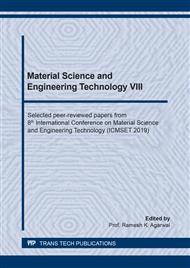p.90
p.96
p.102
p.108
p.114
p.123
p.134
p.140
p.146
Pyrolysis Kinetics of Polypropylene and High Density Polyethylene Wastes Using Kaolin Catalyst
Abstract:
Plastic is materials that are not easily broken down, so it can cause a variety of complex problems such as loss of natural resources, environmental pollution, and depletion of landfill space. Plastic favored by the public is Polypropylene (PP) and High Density Polyethylene (HDPE) for example, food storage, transparent drinking glasses and drinking bottles for babies. This will be a problem in the future. Some alternatives used to reduce the volume of plastic waste are the thermal transformation process which is divided into three types of processing, namely combustion, gasification, and pyrolysis. Pyrolysis is a process of thermal degradation of long chains into smaller molecules. The process of pyrolysis in this study used a variety of catalysts (without catalyst, 5%, 10%, 15%, and 20%) and used variations in particle size, namely size I (30 cm3); size II (7.5 cm3); size III (1,875 cm3) weighing 350 grams of plastic cups and 350 grams of bottle caps. Pyrolysis run for 100 minutes and took the result of pyrolysis every 20 minutes interval. The test carried out by using proximate analysis, fuel specification analysis, and GC-MS. Based on the result of research conducted on the pyrolysis process of a mixture of HDPE and PP variations of catalysts, it obtained optimum liquid and gas yields of 98.57% and 1.43%. Besides, in the size variation, the optimum liquid and gas yield was 96.57% and 3.43%. The proximate result has fulfilled the conditions set by the value of ash content, fly substance, and carbon bound 0.15%; 99.57%; 0.28%. In the GC-MS (Gas Chromatography-Mass Spectrometry) test the highest % area was 39.18% with C9H18 or 2,4-dimethyl-1-heptane compounds. The best simulation result obtained the value of activation energy and reaction speed for liquid and gas in the variation of the catalyst of (87,930.07; 101,527.17) J/mol and (2.03 x 102; 3.74 x 103).
Info:
Periodical:
Pages:
114-119
Citation:
Online since:
June 2020
Authors:
Keywords:
Price:
Сopyright:
© 2020 Trans Tech Publications Ltd. All Rights Reserved
Share:
Citation:


